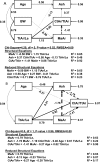Biological co-adaptation of morphological and composition traits contributes to mechanical functionality and skeletal fragility
- PMID: 17922614
- PMCID: PMC2665697
- DOI: 10.1359/jbmr.071014
Biological co-adaptation of morphological and composition traits contributes to mechanical functionality and skeletal fragility
Abstract
A path analysis was conducted to determine whether functional interactions exist among morphological, compositional, and microstructural traits for young adult human tibias. Data provided evidence that bone traits are co-adapted during ontogeny so that the sets of traits together satisfy physiological loading demands. However, certain sets of traits are expected to perform poorly under extreme load conditions.
Introduction: Previous data from inbred mouse strains suggested that biological processes within bone co-adapt morphological and compositional traits during ontogeny to satisfy physiological loading demands. Similar work in young adult humans showed that cortical tissue from slender tibias was stiffer, less ductile, and more susceptible to accumulating damage. Here we tested whether the relationships among morphology and tissue level mechanical properties were the result of biological processes that co-adapt physical traits, similar to those observed for the mouse skeleton.
Materials and methods: Cross-sectional morphology, bone slenderness (Tt.Ar/Le), and tissue level mechanical properties were measured from tibias from 14 female (22-46 yr old) and 17 male (17-46 yr old) donors. Physical bone traits measured included tissue density, ash content, water content, porosity, and the area fractions of osteonal, interstitial, and circumferential lamellar tissues. Bivariate relationships among traits were determined using linear regression analysis. A path analysis was conducted to test the hypothesis that Tt.Ar/Le is functionally related to mineralization (ash content) and the proportion of total area occupied by cortical bone.
Results: Ash content correlated negatively with several traits including Tt.Ar/Le and marrow area, indicating that slender bones were constructed of tissue with higher mineralization. Path analysis revealed that slender tibias were compensated by higher mineralization and a greater area fraction of bone.
Conclusions: The results suggest that bone adapts by varying the relative amount of cortical bone within the diaphysis and by varying matrix composition. This co-adaptation is expected to lead to a particular set of traits that is sufficiently stiff and strong to support daily loads. However, increases in mineralization result in a more brittle and damageable material that would be expected to perform poorly under extreme load conditions. Therefore, focusing attention on sets of traits and the relationship among traits may advance our understanding of how genetic and environmental factors influence bone fragility.
Figures





Similar articles
-
Relationship between bone morphology and bone quality in male tibias: implications for stress fracture risk.J Bone Miner Res. 2005 Aug;20(8):1372-80. doi: 10.1359/JBMR.050326. Epub 2005 Mar 28. J Bone Miner Res. 2005. PMID: 16007335
-
Genetic randomization reveals functional relationships among morphologic and tissue-quality traits that contribute to bone strength and fragility.Mamm Genome. 2007 Jul;18(6-7):492-507. doi: 10.1007/s00335-007-9017-5. Epub 2007 Jun 8. Mamm Genome. 2007. PMID: 17557179 Free PMC article.
-
Biological constraints that limit compensation of a common skeletal trait variant lead to inequivalence of tibial function among healthy young adults.J Bone Miner Res. 2011 Dec;26(12):2872-85. doi: 10.1002/jbmr.497. J Bone Miner Res. 2011. PMID: 21898595
-
The structural and biomechanical basis of the gain and loss of bone strength in women and men.Endocrinol Metab Clin North Am. 2003 Mar;32(1):25-38. doi: 10.1016/s0889-8529(02)00078-6. Endocrinol Metab Clin North Am. 2003. PMID: 12699291 Review.
-
The aging of Wolff's "law": ontogeny and responses to mechanical loading in cortical bone.Am J Phys Anthropol. 2004;Suppl 39:63-99. doi: 10.1002/ajpa.20155. Am J Phys Anthropol. 2004. PMID: 15605390 Review.
Cited by
-
Sex-specific regulation of body size and bone slenderness by the acid labile subunit.J Bone Miner Res. 2010 Sep;25(9):2059-68. doi: 10.1002/jbmr.94. J Bone Miner Res. 2010. PMID: 20499371 Free PMC article.
-
Microhardness distribution of the tibial diaphysis and test site selection for reference point indentation technique.Medicine (Baltimore). 2019 Jul;98(29):e16523. doi: 10.1097/MD.0000000000016523. Medicine (Baltimore). 2019. PMID: 31335730 Free PMC article.
-
Fracture risk predictions based on statistical shape and density modeling of the proximal femur.J Bone Miner Res. 2014 Sep;29(9):2090-100. doi: 10.1002/jbmr.2241. J Bone Miner Res. 2014. PMID: 24692132 Free PMC article.
-
Are we taking full advantage of the growing number of pharmacological treatment options for osteoporosis?Curr Opin Pharmacol. 2014 Jun;16:64-71. doi: 10.1016/j.coph.2014.03.006. Epub 2014 Apr 16. Curr Opin Pharmacol. 2014. PMID: 24747363 Free PMC article. Review.
-
Phenotypic integration of skeletal traits during growth buffers genetic variants affecting the slenderness of femora in inbred mouse strains.Mamm Genome. 2009 Jan;20(1):21-33. doi: 10.1007/s00335-008-9158-1. Epub 2008 Dec 5. Mamm Genome. 2009. PMID: 19082857 Free PMC article.
References
-
- Albright F, Smith PH, Richardson AM. Post-menopausal osteoporosis. Its clinical features. JAMA. 1941;116:2465–2474.
-
- Landin L, Nilsson BE. Bone mineral content in children with fractures. Clin Orthop Relat Res. 1983;178:292–296. - PubMed
-
- Chan GM, Hess M, Hollis J, Book LS. Bone mineral status in childhood accidental fractures. Am J Dis Child. 1984;138:569–570. - PubMed
-
- Milgrom C, Giladi M, Stein M, Kashtan H, Margulies JY, Chisin R, Steinberg R, Aharonson Z. Stress fractures in military recruits. A prospective study showing an unusually high incidence. J Bone Joint Surg Br. 1985;67:732–735. - PubMed
-
- Giladi M, Milgrom C, Simkin A, Stein M, Kashtan H, Margulies J, Rand N, Chisin R, Steinberg R, Aharonson Z, Kadem R, Frankel VH. Stress fractures and tibial bone width. A risk factor. J Bone Joint Surg Br. 1987;69:326–329. - PubMed
Publication types
MeSH terms
Grants and funding
LinkOut - more resources
Full Text Sources
Medical
Research Materials
Miscellaneous

